 W
WThe 6 inch howitzer, model of 1908 was the standard American heavy howitzer before World War I. Forty-two of these weapons had been produced before 1917, and all were employed within the US for training in that war. Although this weapon appears in World War I-era tables of organization and equipment, for combat use in France the Canon de 155 C mle 1917 Schneider was purchased, and variants of this remained the standard weapon of this class until early World War II. All surviving weapons were retired during the 1920s.
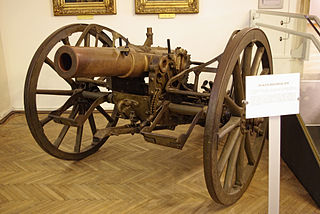 W
WThe 10 cm Feldhaubitze M 99 was a howitzer used by Austria-Hungary during World War I.
 W
WThe 10 cm Gebirgshaubitze M 8 was a mountain howitzer used by Austria-Hungary during World War I. It was the first Austrian howitzer to use a modern hydraulic variable-recoil system. It used the same ammunition as the earlier 10 cm Gebirgshaubitze M 99, which was shown to be accurate, but lacked sufficient power to destroy bunkers, during World War I. It had a gun shield. It could be mounted on a special sled carriage designated 10 cm M. 8 Gebirgsschleife designed to allow for high-angle fire between +43° and 70° elevation. This sled was transported on a special bedding cart with removable wheels. The wheels were removed when in position to fire.
 W
WThe 10 cm Gebirgshaubitze M 99 was a mountain howitzer used by Austria-Hungary during World War I. It consisted of the bronze barrel of the 10 cm Feldhaubitze M 99 on a new, narrow-gauge box trail carriage that could be broken down for transport on animal carts. Like its brother, it lacked a modern recoil system, using only an ineffective spring-mounted recoil spade, and was virtually obsolescent upon its introduction. Relatively few were made as the version of the standard 10 cm Feldhaubitze M 99 with a narrow, 1.3-metre (51 in) carriage was cheaper.
 W
WThe 10 cm M. 14 Feldhaubitze was a dual-purpose field and mountain gun used by Austria-Hungary during World War I. Between the wars it was used by Austria, Italy, and Poland. During World War II it served as the standard medium howitzer of the Royal Italian Army with the designation Obice da 100/17 modello 14 and after 1943 captured weapons were used by Nazi Germany's Wehrmacht under the designations 10 cm leFH 14(ö) and 10 cm leFH 315(i). After World War II an updated howitzer remained in service with the Italian Army until 1975.
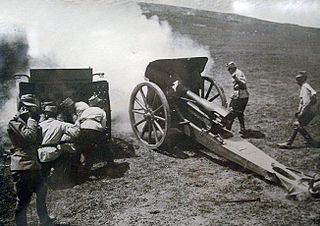 W
WThe Obuzierul Krupp, caliber 105 mm, model 1912 was a Romanian upgrade of the German 10.5 cm Feldhaubitze 98/09 howitzer used extensively during World War I. After two years of planning and experimentation by Romanian officers, the final design was approved and the required modifications were performed at Arsenalul Armatei in Bucharest. The German aiming system was replaced with an improved Romanian system and the maximum range was increased to 6,500 meters, being superior to the 6,300 meters maximum range of its German counterpart. Maximum elevation was also increased from 40° to 60°. Thirty batteries were converted by Arsenalul Armatei before and during World War I. They appear to have lingered in Romanian service into World War II. Guns captured by the Bulgarians appear to have been placed into service, although they seem to have been out of service by the outbreak of World War II.
 W
WThe 10.5 cm leichte Feldhaubitze 16 was a field howitzer used by Germany in World War I and World War II.
 W
WThe 15 cm Mörser M 80 was a heavy howitzer used by Austria-Hungary in World War I. It had a bronze barrel and was intended for siege work, although it had carriages suitable for both field and siege duties. The siege carriage was a steel sledge-type and was equipped with a hydraulic braking device to help absorb the recoil forces. Two wheels could be attached to the front of the carriage and a limber attached to the rear for transport. The field carriage relied on chock blocks and a rope brake device to absorb the gun's recoil.
 W
WThe 15 cm schwere Feldhaubitze M 14 was a heavy howitzer which served with Austria-Hungary during World War I.
 W
WThe 15 cm schwere Feldhaubitze M 94 was a heavy howitzer used by Austria-Hungary in World War I. It had a bronze barrel and relied on wheel ramps to absorb its recoil. The barrel was modified in 1899 as the M 99 and can be identified by its octagonal shape. Both howitzers could be mounted on a wide variety of carriages to suit their mission, including a carriage only 1.13 metres (44 in) wide for mountain use. Around the start of the 20th century both the M 94 and M 99 were modified to increase their elevation up to 65°. The elevation arc had to be extended and the trunnion mounts and wheels had to be strengthened to withstand the greater recoil forces when firing at high elevation. They were known as the M 94/4 and the M 99/4 after modification.
 W
WThe 15 cm schwere Feldhaubitze M. 15 was a heavy howitzer used by Austria-Hungary in World War I. Austrian and Czech guns were taken into Wehrmacht service after the Anschluss and the occupation of Czechoslovakia as the 15 cm schwere Feldhaubitze 15(t) or (ö).
 W
WThe 15 cm schwere Feldhaubitze 1902 was a German heavy field howitzer cannon introduced in 1903 and served in World War I.
 W
WThe 15 cm schwere Feldhaubitze 13, was a heavy field howitzer used by Germany in World War I and the beginning of World War II.
 W
WThe 18 cm kurze Kanone M 80 was a heavy siege howitzer used by Austria-Hungary during World War I. Designed to replace the M 61 series of siege guns the M 80 family of siege guns offered greater range and armor penetration than the older guns. The proven steel-bronze was used for the barrel and the iron carriage lacked any system to absorb recoil other than the traditional recoil wedges placed underneath and behind the wheels of the carriage. These wedges helped to absorb the recoil force and encouraged the wheels to run forward to bring the gun back into battery. Generally a wooden firing platform was constructed for these guns in action to provide a level and smooth surface. For transport the barrel was removed from the carriage by a crane and carried separately.
 W
WThe 21 cm Mörser 10 was a heavy howitzer used by Germany in World War I. It replaced the obsolete 21 cm Mörser 99, which lacked a recoil system. For transport, it broke down into two loads. Some howitzers were fitted with a Gun shield during the war. As it was also intended for siege use, a concrete-penetrating shell was also used. Unusually, it had two spades: a folding one halfway down the trail and a fixed one at the end of the trail.
 W
WThe 21 cm Mörser 16, or 21 cm Lange Mörser M 16/L14.5, was a heavy howitzer used by Germany in World War I and World War II.
 W
WThe 24 cm Mörser M 98 was a heavy siege howitzer used by Austria-Hungary during World War I. It was designed to attack modern fortifications, but its short range and ineffective ammunition led to the development of the more deservedly famous 30.5 cm Mörser M 11 and M 16.
 W
WThe 38 cm Belagerungshaubitze M 16 was a super-heavy siege howitzer used by Austria-Hungary during World War I.
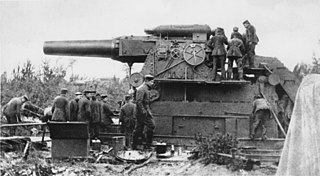 W
WThe 42 cm kurze Marinekanone L/12, or Gamma-Gerät, was a German siege gun built by Krupp. The Gamma-Gerät's barrel diameter was 42 cm (17 in), making it one of the largest artillery pieces ever fielded. It was designed from 1906 to 1910, then used by the Imperial German Army during World War I at various sieges and battles in Belgium, France, Poland, and Serbia. A single Gamma-Gerät survived World War I and saw limited use in World War II by the Wehrmacht to attack the Maginot Line and besiege Sevastopol.
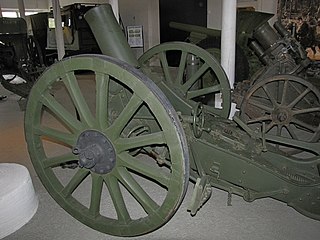 W
WThe 120 mm howitzer Model 1901 – was a German howitzer used by the Imperial Russian and Romanian Armies during the First World War.
 W
WThe 120 mm Krupp howitzer M1905 was a howitzer used by Turkey, Japan and a few smaller armies including during World War I. After the Ottoman Empires entrance into World War I in 1914 on the side of the Central Powers, it realized that it needed to modernize its artillery. The Model 1905 was a "stock gun" from Krupp that could be supplied to customers from parts on hand, on short notice and with minor alterations to suit the customers' needs. The Model 1905 was a conventional artillery piece for its time, except for a lack of a Gun shield for the crew. The lack of a Gun shield was not a major liability, as most artillery quickly moved into concealed positions after the first few months of war.
 W
WThe 152 mm howitzer M1909 was a Russian Empire 152.4 mm howitzer. Developed by the French arms manufacturer Schneider et Cie it saw service throughout World War I.
 W
WThe 152 mm howitzer Model 1910 Schneider or, more properly, 6 dm polevaja gaubitsa sistemy Schneidera as it was designated in Tsarist times, was a French howitzer designed by Schneider et Cie. It was used by the Russian Empire and the Soviet Union during World War I, the Russo-Polish War and the Russian Civil War. Finland captured nine during the Finnish Civil War, but did not use them during that conflict. They did see combat during the Winter War and the Continuation War.
 W
WType 1915 305 mm howitzer was a Russian heavy howitzer that saw service during World War I and II. Originally intended for Naval use, it was later purchased by the Army at a cost of 271,500 Rubles apiece, with the first order of 8 being sent on 13 August 1915.
 W
WThe 42 cm kurze Marinekanone 14 L/12, or Minenwerfer-Gerät (M-Gerät), popularly known by the nickname Big Bertha, was a German siege howitzer built by Krupp AG in Essen, Germany and fielded by the Imperial German Army from 1914 to 1918. The M-Gerät had a 42-centimetre (17 in) calibre barrel, making it one of the largest artillery pieces ever fielded. It was first designed in 1911 and entered production the next year. Test firing began in early 1914, and the gun was estimated to be finished by October. When World War I broke out, the two available M-Gerät guns, still prototypes, were sent to Liège and destroyed Forts Pontisse and Loncin. German soldiers bestowed the gun with the nickname "Big Bertha," which then spread through German newspapers to the Allies, who used it as a nickname for all superheavy German artillery. The Paris Gun, used in 1918 after all Big Berthas had been removed from service, has historically been confused for the M-Gerät.
 W
WThe Ordnance BL 5-inch howitzer was initially introduced to provide the Royal Field Artillery with continuing explosive shell capability following the decision to concentrate on shrapnel for field guns in the 1890s.
 W
WThe Ordnance BL 5.4-inch howitzer was a version of the British 5-inch howitzer designed for British Indian Army use, especially on the Northwest Frontier.
 W
WThe Ordnance BL 6 inch 26cwt howitzer was a British howitzer used during World War I and World War II. The qualifier "26cwt" refers to the weight of the barrel and breech together which weighed 26 long hundredweight (1.3 t).
 W
WThe Ordnance BL 6 inch 30cwt howitzer was a British medium howitzer used in the Second Boer War and early in World War I. The qualifier "30cwt" refers to the weight of the barrel and breech together which weighed 30 hundredweight (cwt) : 30 × 112 lb = 3,360 lb. It can be identified by the slightly flared shape of the muzzle and large recuperator springs below the barrel.
 W
WThe BL 8-inch howitzer Mark I through to Mark V were a British improvisation developed early in the First World War to provide heavy artillery. It used shortened and bored-out barrels from various redundant naval 6-inch guns.
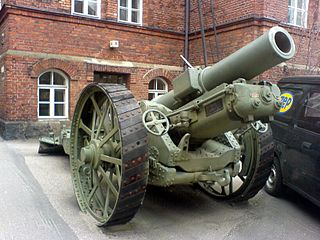 W
WThe BL 8-inch howitzer Marks VI, VII and VIII were a series of British artillery siege howitzers on mobile carriages of a new design introduced in World War I. They were designed by Vickers in Britain and produced by all four British artillery manufacturers, but mainly by Armstrong, and one American company. They were the equivalents of the German 21 cm Morser 16 and in British service were used similarly to the BL 9.2-inch howitzer, but were quicker to manufacture, and more mobile. They delivered a 200 lb (91 kg) shell to 12,300 yards (11.2 km). They had limited service in the British Army in World War II before being converted to the new 7.2-inch (180 mm) calibre. They also equipped a small number of Australian and Canadian batteries in World War I and by the US Army in that war. They were used in small numbers by other European armies.
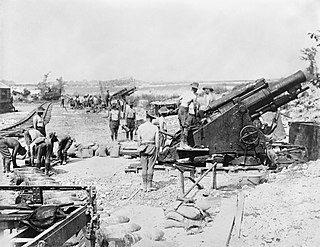 W
WThe Ordnance BL 9.2-inch howitzer was a heavy siege howitzer that formed the principal counter-battery equipment of British forces in France in World War I. It equipped a substantial number of siege batteries of the Royal Garrison Artillery. It remained in service until about the beginning of World War II.
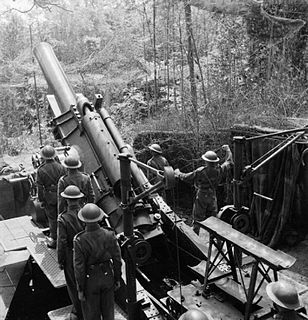 W
WThe Ordnance BL 12-inch howitzer was a scaled-up version of the successful BL 9.2-inch siege howitzer.
 W
WThe British Ordnance BL 12 inch howitzer on truck, railway, a type of railway gun, was developed following the success of the 9.2-inch siege howitzer. It was similar but unrelated to the 12-inch siege howitzers Mk II and IV.
 W
WThe Ordnance BL 15-inch howitzer was developed by the Coventry Ordnance Works late in 1914 in response to the success of its design of the 9.2-inch siege howitzer.
 W
WThe Canon de 155 C modèle 1915 Saint-Chamond was a French howitzer used during World War I. It was based on a private prototype of a 150 millimetres (5.9 in) howitzer presented to the Mexican government in 1911. The French government ordered 400 Saint-Chamond howitzers in 1915, these being delivered starting in late 1916. Small numbers of Saint-Chamond howitzers were given to the Serbian and Romanian armies towards the end of World War I. The Saint-Chamond howitzer served in the French Army after World War I and were mobilised at the outbreak of World War II. Finland bought 24 Saint-Chamond howitzers during the Winter War and these served until the 1960s. The German Army captured some Saint-Chamond howitzers after the fall of France and used these mostly as coastal defence guns until the end of World War II.
 W
WThe Canon de 155 C modèle 1917 Schneider, often abbreviated as the C17S, was a French howitzer designed by Schneider. It was essentially the Canon de 155 C modèle 1915 Schneider fitted with a different breech to use bagged propellant rather than the cartridge cases used by the older howitzer. It was used by France, Russian Empire, Belgium, Rumania, and the United States from 1917 during World War I and was widely exported after the war. Surviving weapons were in service with France, Poland, Greece, Italy, Belgium, the United States, and Finland during World War II. Captured weapons were used by the Germans for their 2nd-line artillery and coast defense units.
 W
WThe Mortier de 280 TR Modèle 1914 Schneider was a French siege howitzer manufactured by the Schneider et Cie company, used during World War I. The howitzer had its origins from a Russian Army policy to upgrade its artillery park after the poor showing of Russian artillery in the 1904-5 Russo-Japanese war. In 1909 an agreement was signed between Schneider and the Russian armaments manufacturer Putilov to jointly develop and produce a number of artillery types. One of these types was a 279.4 mm (11-inch) siege howitzer with a range of 6,000 m (20,000 ft) to replace very old Russian guns of similar calibre. Schneider delivered the first prototype of the siege howitzer to the Russians in 1912 for extensive testing. Although the Russians found the gun was unable to penetrate the heaviest reinforced concrete fortifications its general performance was judged satisfactory which led to an order for 16 howitzers to be delivered in 1915. The French Army expressed interest in the Schneider howitzer as a possible replacement for the Mortier de 370 Mle 1885 De Bange. After some dithering by French authorities 18 howitzers were ordered in 1913. Delivery of the howitzers to Russia and France was delayed by the general mobilisation of 1914 which disrupted industrial production. During the war 126 howitzers were delivered to the French Army and 26 to Russia as the 280 mm Schneider Mortar Model 1914/15 before the 1917 revolutions. In addition another 25 barrels were installed post-WW1 on the Saint-Chamond heavy self-propelled gun chassis as the Mortier 280 mm TR de Schneider sur affût-chenilles St Chamond.
 W
WThe Obusier de 520 modèle 1916 was a French railway howitzer that was built during World War I, but did not see service before the war ended. One weapon was destroyed in firing trials and the other was captured by the Germans after France surrendered in 1940 and used by them in the siege of Leningrad. Both weapons were destroyed by premature detonations of shells in their barrels.
 W
WOrdnance, QF 3.7-inch howitzer is a mountain gun, used by British and Commonwealth armies in the First and Second World Wars, and between the wars.
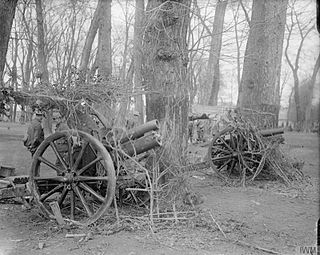 W
WThe Ordnance QF 4.5-inch howitzer was the standard British Empire field howitzer of the First World War era. It replaced the BL 5-inch howitzer and equipped some 25% of the field artillery. It entered service in 1910 and remained in service through the interwar period and was last used in the field by British forces in early 1942. It was generally horse drawn until mechanisation in the 1930s.
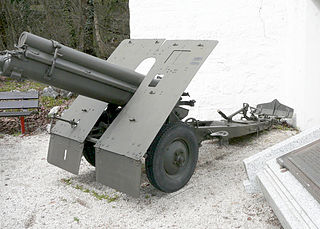 W
WThe Skoda 100 mm Model 1916 was a mountain howitzer used by Austria-Hungary during World War I. The Turks used a 105 mm variant, the M.16(T). The Wehrmacht redesignated this as the 10 cm GebH 16 or 16(ö). Guns acquired from Italy, after 1943, were known as 10 cm GebH 316(i); those acquired from Czechoslovakia were 10 cm GebH 16(t). The Italians referred to weapons gained either through capture or reparations as the Obice da 100/17 modello 16. The gun could be broken into three sections, intended for towing by two animal carts. The gun crew was protected by a gun shield. The Italians used lighter shells than the Czechs, which accounts for the greater range and muzzle velocity of their guns.
 W
WThe Škoda 30.5 cm Mörser M.11 was a siege howitzer produced by Škoda Works and used by the Austro-Hungarian Army during World War I and by Nazi Germany in World War II.
 W
WThe Type 38 15 cm Howitzer was a 1905 German design that was purchased by the Empire of Japan as the standard heavy howitzer of the Imperial Japanese Army at the end of the Russo-Japanese War. The Type 38 designation was given to this gun as it was accepted in the 38th year of Emperor Meiji's reign (1905).